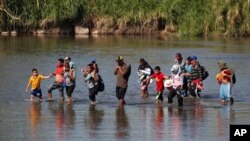Hundreds of Central American migrants who entered southern Mexico in recent days have either been pushed back into Guatemala by Mexican troops, shipped to detention centers or returned to Honduras, officials said Tuesday. An unknown number slipped past Mexican authorities and continued north.
The latest migrant caravan provided a public platform for Mexico to show the U.S. government and migrants thinking of making the trip that it has refined its strategy and produced its desired result: This caravan will not advance past its southern border.
What remained unclear was the treatment of the migrants who already find themselves on their way back to the countries they fled last week.
"Mexico doesn't have the capacity to process so many people in such a simple way in a couple of days," said Guadalupe Correa Cabrera, a professor at George Mason University studying how the caravans form.
The caravan of thousands had set out from Honduras in hopes Mexico would grant them passage, posing a fresh test of U.S. President Donald Trump's effort to reduce the flow of migrants arriving at the U.S. border by pressuring other governments to stop them.
Mexican Foreign Secretary Marcelo Ebrard said 2,400 migrants entered Mexico legally over the weekend. About 1,000 of them requested Mexico's help in returning to their countries. The rest were being held in immigration centers while they start legal processes that would allow them to seek refuge in Mexico or obtain temporary work permits that would confine them to southern Mexico.
On Tuesday afternoon, Jesus, a young father from Honduras who offered only his first name, rested in a shelter in Tecun Uman, Guatemala, with his wife and their baby, unsure of what to do next.
"No country's policy sustains us," he said in response to hearing Ebrard's comments about the situation. "If we don't work, we don't eat. (He) doesn't feed us, doesn't care for our children."
Honduran officials said more than 600 of its citizens were expected to arrive in that country Tuesday by plane and bus and more would follow in the coming days.
Of an additional 1,000 who tried to enter Mexico illegally Monday by wading across the Suchiate river, most were either forced back or detained later by immigration agents, according to Mexican officials.
Most of the hundreds stranded in the no-man's land on the Mexican side of the river Monday night returned to Guatemala in search of water, food and a place to sleep. Late Tuesday, the first buses carrying Hondurans left Tecun Uman with approximately 150 migrants heading back to their home country.
Mexican authorities distributed no water or food to those who entered illegally, in what appeared to be an attempt by the government to wear out the migrants.
Alejandro Rendon, an official from Mexico's social welfare department, said his colleagues were giving water to those who turned themselves in or were caught by immigration agents, but were not doing the same along the river because it was not safe for workers to do so.
"It isn't prudent to come here because we can't put the safety of the colleagues at risk,'' he said.
Mexican President Andres Manuel Lopez Obrador said Tuesday that the government is trying to protect the migrants from harm by preventing them from traveling illegally through the country. He said they need to respect Mexican laws.
"If we don't take care of them, if we don't know who they are, if we don't have a register, they pass and get to the north, and the criminal gangs grab them and assault them, because that's how it was before," he said. "They disappeared them."
Mexican Interior Minister Olga Sanchez Cordero commended the National Guard for its restraint, saying: "In no way has there been an act that we could call repression and not even annoyance."
But Honduras' ambassador to Mexico said there had been instances of excessive force on the part of the National Guard. "We made a complaint before the Mexican government," Alden Rivera said in an interview with HCH Noticias without offering details. He also conceded migrants had thrown rocks at Mexican authorities.
An Associated Press photograph of a Mexican National Guardsman holding a migrant in a headlock was sent via Twitter by acting U.S. Homeland Security Secretary Ken Cuccinelli with the message: "We appreciate Mexico doing more than they did last year to interdict caravans attempting to move illegally north to our southern border."
"They absolutely must be satisfied with (Mexico's) actions because in reality it's their (the United States') plan," said Correa Cabrera, the George Mason professor. "They're congratulating themselves, because in reality it wasn't Lopez Obrador's plan."
She said it is an complicated issue for Mexico, but the National Guard had no business being placed at the border to handle immigration because they weren't trained for it. The government "is sending a group that doesn't know how to and can't protect human rights because they're trained to do other kinds of things,'' she said.
Mexico announced last June that it was deploying the newly formed National Guard to assist in immigration enforcement to avoid tariffs that Trump threatened on Mexican imports.
Darlin Rene Romero and his wife were among the few who spent the night pinned between the river and Mexican authorities.
Rumors had circulated through the night that "anything could happen, that being there was very dangerous," Romero said. But the couple from Copan, Honduras, spread a blanket on the ground and passed the night 20 yards from a line of National Guard troops forming a wall with their riot shields.
They remained confident that Mexico would allow them to pass through and were trying to make it to the northern Mexican city of Monterrey, where his sister lives.
They said a return home to impoverished and gang-plagued Honduras, where most of the migrants are from, was unthinkable.






